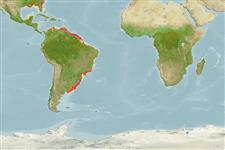ກຸ່ມປາກະດູກອ່ອນ (ເຊັ່ນ: ປາສະຫລາມ, ປາຜາໄລ) (sharks and rays) >
Myliobatiformes (Stingrays) >
Myliobatidae (Eagle and manta rays)
Etymology: Myliobatis: Greek, mylo = mill + Greek, + Greek, batis,-idos = a ray (Raja sp.) (Ref. 45335).
Eponymy: Dr George Brown Goode (1851–1896) was an American ichthyologist and museum administrator at the Smithsonian. [...] (Ref. 128868), visit book page.
More on author: Garman.
Environment: milieu / climate zone / depth range / distribution range
ນິເວດວິທະຍາ
ສັດທະເລ ກ່ຽວກັບ (ຢູ່)ເທິງຊັ້ນພື້ນດິນໃນທະເລເປີດ; ລະດັບຄວາມເລິກ 1 - 130 m (Ref. 57911). Tropical; 33°N - 40°S, 180°W - 180°E
Worldwide in tropical waters. Western Atlantic: South Carolina, USA to Argentina. Often confused with Myliobatis freminvillii.
ຂະໜາດ / ນ້ຳໜັກ / Age
Maturity: Lm ? range ? - ? cm
Max length : 125 cm TL ຕົວຜູ້/ບໍ່ມີເພດ; (Ref. 57911); common length : 80.0 cm WD ຕົວຜູ້/ບໍ່ມີເພດ; (Ref. 6077)
Smaller dorsal fin set farther back on tail, well beyond the pelvic fins. Disk broader, with more rounded corners of wings. Snout less projecting. No spines on disk (Ref. 7251). Broader separation between the inner ends of gill openings. Chocolate or greyish brown above and brownish white below (Ref. 6902).
Ovoviviparous (Ref. 50449). In coastal waters down to 130 m.
Life cycle and mating behavior
ການຈະເລີນເຕັມໄວ | ການສືບພັນ | ການວາງໄຂ່ | ໄຂ່ | ຄວາມດົກຂອງໄຂ່ປາ | ຕົວອ່ອນ
Exhibit ovoviparity (aplacental viviparity), with embryos feeding initially on yolk, then receiving additional nourishment from the mother by indirect absorption of uterine fluid enriched with mucus, fat or protein through specialised structures (Ref. 50449).
Robins, C.R. and G.C. Ray, 1986. A field guide to Atlantic coast fishes of North America. Houghton Mifflin Company, Boston, U.S.A. 354 p. (Ref. 7251)
IUCN Red List Status (Ref. 130435: Version 2024-1)
Threat to humans
Harmless
Human uses
ການປະມົງ: ທີ່ເປັນການຄ້າໜ້ອຍ
ເຄື່ອງມື
Special reports
Download XML
ແຫຼ່ງອີນເຕີເນັດ
Estimates based on models
Preferred temperature (Ref.
123201): 13.3 - 27.8, mean 24.4 °C (based on 732 cells).
Phylogenetic diversity index (Ref.
82804): PD
50 = 0.5002 [Uniqueness, from 0.5 = low to 2.0 = high].
Bayesian length-weight: a=0.00389 (0.00119 - 0.01269), b=3.08 (2.83 - 3.33), in cm total length, based on LWR estimates for this (Sub)family-body shape (Ref.
93245).
ຊັ້ນເຂດຮ້ອນ (Ref.
69278): 3.3 ±0.34 se; based on food items.
ຄວາມຢືດຢຸ່ນ (Ref.
120179): ຕຳ່ຫຼາຍ, ປະຊາກອນຕຳ່ສຸດທີ່ໃຊ້ເວລາສອງເທົ່າຫຼາຍກວ່າ 14 ປີ (Fec assumed to be <10).
Fishing Vulnerability (Ref.
59153): High to very high vulnerability (75 of 100).
Nutrients (Ref.
124155): Calcium = 22.5 [6.6, 112.7] mg/100g; Iron = 0.637 [0.161, 1.754] mg/100g; Protein = 20.6 [15.6, 25.8] %; Omega3 = 0.153 [0.043, 0.476] g/100g; Selenium = 61.5 [15.7, 183.1] μg/100g; VitaminA = 14.3 [5.5, 36.8] μg/100g; Zinc = 0.875 [0.426, 1.585] mg/100g (wet weight);
